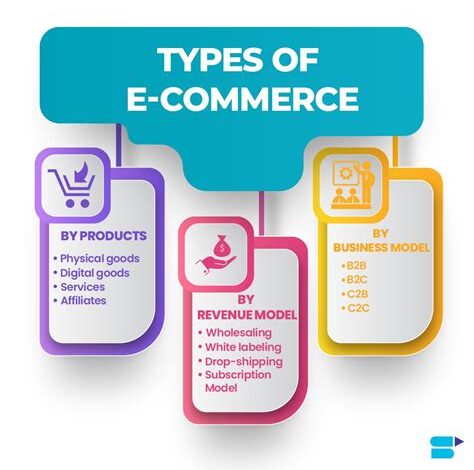E-commerce Business Models for Beginners

Learn about various e-commerce business models including direct-to-consumer, subscription-based, and dropshipping. Discover how to choose the right model for your online business.In today’s digital age, starting an e-commerce business has become more accessible than ever. However, with the prevalence of different business models, choosing the right one for your online store can be overwhelming, especially for beginners. In this blog post, we will explore the various e-commerce business models to help you understand their differences and determine which one suits your entrepreneurial goals.
We will start by breaking down the different e-commerce business models, including direct-to-consumer, subscription-based, and dropshipping models. Understanding each model’s unique characteristics and requirements will provide you with a comprehensive overview of the e-commerce landscape. From there, we will delve into how to choose the right business model based on your niche, target audience, and operational capabilities. Whether you’re looking to sell a niche product or provide a subscription service, we’ll analyze the pros and cons of each model to equip you with the knowledge needed to make an informed decision when building your e-commerce venture.
Understanding E-commerce Business Models
When starting an e-commerce business, it’s crucial to understand the different business models that are available to you. Each model has its own set of advantages and disadvantages, and choosing the right one can greatly impact the success of your online venture.
One common e-commerce business model is the direct-to-consumer model, which involves selling products directly to customers through your own website or online store. This allows you to have more control over the customer experience and build a loyal customer base, but it also requires significant investment in marketing and customer acquisition.
Another popular model is the subscription-based model, where customers pay a recurring fee for access to a product or service. This can provide a steady, predictable stream of revenue, but it also requires a strong value proposition and ongoing customer engagement to retain subscribers.
Choosing the Right Business Model
When starting an e-commerce business, one of the most important decisions you will make is choosing the right business model. With so many options available, it can be overwhelming to decide which model is the best fit for your products and target market.
One of the first things to consider when choosing a business model is the type of products you will be selling. For example, if you plan to sell unique, handcrafted items, a direct-to-consumer model may be the best option. On the other hand, if you are planning to sell a wide range of products from various suppliers, a dropshipping model may be more suitable.
Another important factor to consider is your target market. If you are targeting a niche market with a specific need, a subscription-based model may work best. However, if you are targeting a broader audience with diverse preferences, a more traditional e-commerce model may be the way to go.
Exploring Direct-to-Consumer Model
E-commerce business has undergone various evolutions and one of the most popular business models is the direct-to-consumer model. This model involves selling products directly to consumers without any intermediaries such as retailers or wholesalers. Businesses that adopt this model are able to establish a direct relationship with their customers, gather valuable data, and have full control over the customer experience.
One of the key advantages of the direct-to-consumer model is the ability to build a strong brand through direct interactions with customers. By selling directly to consumers, businesses can effectively communicate their brand story, values, and mission, creating a more authentic and personalized shopping experience. This direct connection also allows businesses to gather valuable customer feedback, which can be used to improve products and services, and identify new market trends.
Furthermore, the direct-to-consumer model allows businesses to have better control over their pricing strategy and profit margins. By cutting out the middlemen, businesses can offer competitive pricing to consumers while still maintaining healthy profit margins. This model also gives businesses the freedom to experiment with different marketing and sales strategies without having to rely on third-party distributors or retailers.
Analyzing Subscription-based Model
Analyzing Subscription-based Model
In the world of e-commerce, the subscription-based model is becoming increasingly popular. This business model, often used by companies in the software, media, and entertainment industries, involves charging customers a recurring fee in exchange for access to products or services. This model not only provides a steady stream of revenue for businesses, but also fosters customer loyalty and retention.
One of the key benefits of the subscription-based model is the predictable revenue it generates. By charging customers a regular fee, businesses can forecast their income more accurately and have a better understanding of their financial health. This can be particularly beneficial for startups and small businesses looking for stability and consistent cash flow.
Another advantage of the subscription-based model is its ability to build strong, long-lasting relationships with customers. By offering a valuable and continuous service, businesses can create a loyal customer base that is less likely to switch to competitors. Additionally, the recurring payments from subscribers can lead to higher customer lifetime value, providing a higher return on investment for the business.
Implementing Dropshipping Model
Implementing Dropshipping Model
When it comes to starting an e-commerce business, one of the most popular and profitable business models is dropshipping. This model allows you to sell products to customers without holding any inventory. Instead, when a customer makes a purchase, the order is forwarded to a third-party supplier, who then ships the product directly to the customer. This eliminates the need to manage stock, handle shipping, or deal with upfront costs, making it an attractive option for beginners in the e-commerce space.
One of the key advantages of implementing a dropshipping model is the low barrier to entry. You don’t need a large amount of capital to get started, as you don’t have to invest in inventory or warehouse space. This makes it a great option for entrepreneurs who are looking to test the waters in the e-commerce industry without taking on a huge financial risk. Additionally, the dropshipping model allows you to offer a wide variety of products to your customers, without having to worry about managing and shipping each item yourself.
However, there are also some challenges to consider when implementing a dropshipping model. It’s important to choose reputable suppliers who can consistently deliver high-quality products in a timely manner. You’ll also need to carefully manage your margins, as the profit margins in dropshipping are typically lower compared to other e-commerce models. Additionally, customer service is crucial in the dropshipping model, as any issues with orders or products will ultimately reflect on your business. Despite these challenges, with the right research, strategy, and dedication, implementing a dropshipping model can be a lucrative and rewarding venture for e-commerce beginners.





